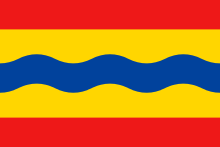Overijssel
| Overijssel | |||
|---|---|---|---|
| Province of the Netherlands | |||
| |||
| Anthem: Aan de rand van Hollands gouwen | |||
 Location of Overijssel in the Netherlands | |||
| Country | Netherlands | ||
| Capital | Zwolle | ||
| Largest city | Enschede | ||
| Government | |||
| • King's Commissioner | Ank Bijleveld (CDA) | ||
| Area | |||
| • Land | 3,327 km2 (1,285 sq mi) | ||
| • Water | 94 km2 (36 sq mi) | ||
| Area rank | 4th | ||
| Population (2006) | |||
| • Land | 1,113,529 | ||
| • Rank | 7th | ||
| • Density | 330/km2 (870/sq mi) | ||
| • Density rank | 7th | ||
| ISO 3166 code | NL-OV | ||
| Religion (2006) |
Protestant 29% Catholic 26% Muslim 2% Others 6% Non-religious 37% | ||
| Website | www.overijssel.nl | ||
Overijssel (Dutch pronunciation: [ˌoːvəˈrɛisəl]; Dutch Low Saxon: Oaveriessel [ˌoːvəˈrisəɫ]) is a province[1] of the Netherlands in the central-eastern part of the country. The province's name translates to "[Land] across the IJssel", from the perspective of the bishopric of Utrecht by which it was held until 1528. The capital city of Overijssel is Zwolle and the largest city is Enschede. The province has a population of 1,113,529 inhabitants.
Geography
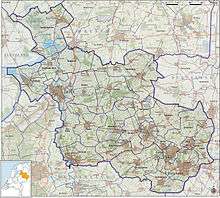
Overijssel is bordered by Germany to the east, the Achterhoek region of Gelderland to the south, the Veluwe region of Gelderland and Flevoland to the west, and Friesland and the former moors of Drenthe to the north. Overijssel comprises three regions: Kop van Overijssel in the northwest, Salland in the centre of the province, and Twente in the east. Besides the capital Zwolle, other major cities are Almelo, Deventer, Enschede, and Hengelo.
To the southeast, the province's surface is mostly sandy, interspersed with small rivers such as the Regge and Dinkel and other brooks. In the northwest, the geology is dominated by sediments from the Overijsselse Vecht and clay. The northern parts were once covered by veen (bogs) which separated the dryer and more arable south from Drenthe and which have been exploited as fuel to a large degree. Only small patches survive today (Engbertsdijksvenen near Tubbergen, Witteveen (near Haaksbergen), and the Aamsveen (near Enschede). The extreme northwest is dominated by a system of lakes formed by former peat-mining, the Weerribben, which is a valuable wetland.
The highest point in Overijssel is the summit of the Tankenberg, a hill in the municipality of Losser, at 89 metres (295 ft). The lowest point is in the Mastenbroek Polder near Kampen at 2 metres (6 ft) below sea level.
Climate
Overijssel enjoys an oceanic climate (Cfb in the Köppen classification). However, winters tend to be less mild than the rest of the Netherlands, because of its distance from the coast.[2]
| Climate data for Twenthe (1981-2010) | |||||||||||||
|---|---|---|---|---|---|---|---|---|---|---|---|---|---|
| Month | Jan | Feb | Mar | Apr | May | Jun | Jul | Aug | Sep | Oct | Nov | Dec | Year |
| Average high °C (°F) | 4.8 (40.6) |
5.7 (42.3) |
9.5 (49.1) |
13.9 (57) |
18.0 (64.4) |
20.5 (68.9) |
22.8 (73) |
22.5 (72.5) |
18.7 (65.7) |
14.1 (57.4) |
8.9 (48) |
5.2 (41.4) |
13.7 (56.7) |
| Daily mean °C (°F) | 2.3 (36.1) |
2.6 (36.7) |
5.6 (42.1) |
8.9 (48) |
12.9 (55.2) |
15.4 (59.7) |
17.6 (63.7) |
17.1 (62.8) |
14.0 (57.2) |
10.2 (50.4) |
6.0 (42.8) |
2.9 (37.2) |
9.6 (49.3) |
| Average low °C (°F) | −0.5 (31.1) |
−0.6 (30.9) |
1.5 (34.7) |
3.4 (38.1) |
7.1 (44.8) |
9.6 (49.3) |
12.0 (53.6) |
11.5 (52.7) |
9.2 (48.6) |
6.2 (43.2) |
3.0 (37.4) |
0.3 (32.5) |
5.2 (41.4) |
| Average precipitation mm (inches) | 71.5 (2.815) |
51.6 (2.031) |
65.1 (2.563) |
45.2 (1.78) |
62.4 (2.457) |
67.7 (2.665) |
74.5 (2.933) |
71.0 (2.795) |
65.4 (2.575) |
67.5 (2.657) |
68.9 (2.713) |
74.1 (2.917) |
784.9 (30.902) |
| Mean monthly sunshine hours | 52.8 | 82.6 | 114.0 | 169.9 | 202.1 | 184.6 | 202.4 | 184.4 | 137.4 | 112.3 | 58.9 | 46.0 | 1,547.3 |
| Source: KNMI [3] | |||||||||||||
History
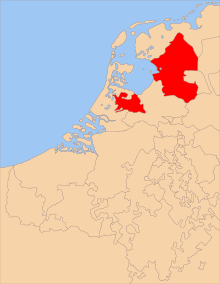
Oversticht
Overijssel was formerly known as Oversticht and also included most of the modern-day province of Drenthe. In 1336, it was made part of Guelders, though it was ceded to the Bishopric of Utrecht in 1347. The Bishops ceded the Oversticht to the Emperor Charles V in 1528, who styled himself Lord of Overijssel, after the Latin name of Oversticht that was known since 1233: Transysla or Transisalania, or Over-IJssel, i.e. the other side of the river IJssel. The people joined with the other Dutch and rebelled against Charles' heir Philip II. Overijssel became governed by the most powerful mayors and lords in the province.
After a brief occupation by the forces of the Bishop of Münster (1672–74), Overijssel received a new form of government which granted the stadtholders more power. Widespread resistance against the increased power throughout the provinces eventually led to the formation of the Batavian Republic in 1795. A centralist government arose and the Netherlands was organised into a series of départements, based on those used by revolutionary France.
Overijssel
At first organised into its own département, it was merged with Drenthe in 1798 to form Ouden IJssel, which was renamed Overijssel in 1801.
The French annexed the Batavian Republic in 1810, and Overijssel was organised into the new French département of Bouches-de-l'Yssel. After the defeat of Napoleon in 1814, the kingdom of the Netherlands and the former province of Overijssel were recreated.
Overijssel was occupied by Nazi Germany during World War II from May 1940 until its liberation in April 1945. The Noordoostpolder, a reclaimed territory which had been laid dry in 1942, was part of Overijssel from 1962 until 1986, when it became part of the newly created province of Flevoland.
Politics
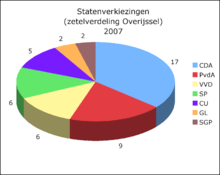
The King's Commissioner of Overijssel is Ank Bijleveld. She is the chairwoman of the States-Deputed (executive branch) and the States-Provincial (elected parliament) of Overijssel.
| 2007 election results | ||
|---|---|---|
| Political party | Votes in % | Seats |
| Christian Democratic Appeal | 34.1 | 17 |
| Dutch Labour Party | 17.9 | 9 |
| People's Party for Freedom and Democracy | 13.6 | 6 |
| Socialist Party (Netherlands) | 11.8 | 6 |
| ChristianUnion | 10.4 | 5 |
| GreenLeft | 4.3 | 2 |
| Reformed Political Party | 3.5 | 2 |
| Democrats 66 | 1.6 | - |
| Pim Fortuyn List | 0.4 | - |
| Total | 47 | |
Transport
There are three main motorways in Overijssel, the A1, A28, and the A35. The A32 also runs through the province, but only for a few kilometers.[4]
The main railway station in Overijssel is the Zwolle railway station, located in the city of Zwolle which serves as hub between the northern provinces and the rest of The Netherlands.
The main active airports in Overijssel is the Enschede Airport Twente, located outside of Enschede. The airport does not currently offer any international flights, though it has historically.[5]
Municipalities
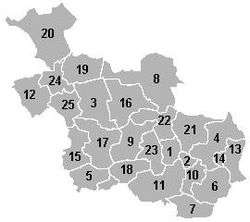
- North Overijssel CORUP group
- Dalfsen (3)
- Hardenberg (8)
- Kampen (12)
- Ommen (16)
- Staphorst (19)
- Steenwijkerland (20)
- Zwartewaterland (24)
- Zwolle (25)
- South West Overijssel CORUP group
- Deventer (5)
- Olst-Wijhe (15)
- Raalte (17)
- Twente CORUP group
- Almelo (1)
- Borne (2)
- Dinkelland (4)
- Enschede (6)
- Haaksbergen (7)
- Hellendoorn (9)
- Hengelo (10)
- Hof van Twente (11)
- Losser (13)
- Oldenzaal (14)
- Rijssen-Holten (18)
- Tubbergen (21)
- Twenterand (22)
- Wierden (23)
See also
- Overisel Township, Michigan, US was named after Overijssel
- Tanfana
References
- ↑ The region has a NUTS classification of NL21.
- ↑ http://www.whatstheweatherlike.org/netherlands/overijssel.htm
- ↑ "Twenthe, long-term averages, time period 1981-2010 (in Dutch)" (PDF). Retrieved December 29, 2012.
- ↑ http://hitchwiki.org/en/Category:Overijssel
- ↑ http://ourairports.com/countries/NL/OV/airports.html?sort=popular
External links
| Wikimedia Commons has media related to Overijssel. |
- Official website
- Participation platform of Overijssel
-
 Overijssel travel guide from Wikivoyage
Overijssel travel guide from Wikivoyage
 |
Friesland | Drenthe | Lower Saxony (DE) |  |
| Flevoland | |
|||
| ||||
| | ||||
| Gelderland | North Rhine-Westphalia (DE) |
